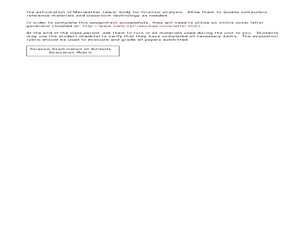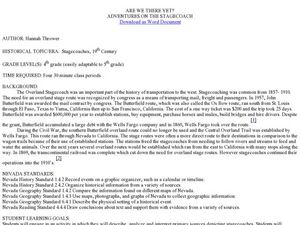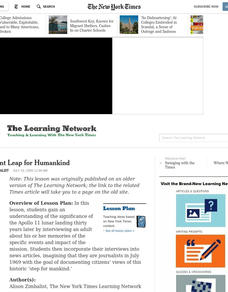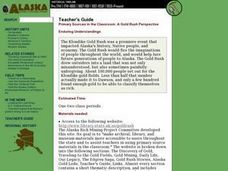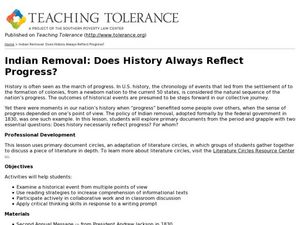Curated OER
The Gettysburg Address
Students become familiar with the Gettysburg Address as well as the historical importance of the document in history. They brainstorm its implications and then in groups translate the language used in the address into modern day...
Curated OER
From Smithson to Smithsonian: Who Was James Smithson?
High schoolers evaluate and examine primary and secondary source material as they relate to the life of James Smithson.In this "From Smithson to Smithsonian" lesson, students analyze documents looking for clues to the identity of James...
Curated OER
Am I Really Free?
Fourth graders write about slavery and freedom. In this freed slaves lesson, 4th graders read historical information about free blacks during slavery and explore books, objects and slave narratives to learn more. Students write a...
Curated OER
Understanding Reconstruction in South Carolina
Eighth graders interpret historical evidence presented in primary and secondary resources. In this Reconstruction lesson, 8th graders research the role of Reconstruction in South Carolina by simulating the environment of East Bay Street...
Curated OER
The Gold Rush Experience: Create Your Own Exhibit
Learners create a virtual exhibit. In this gold rush lesson, students watch a movie about the California gold rush, view a virtual image of the gold nugget that started the gold rush and examine the sources. Learners research and...
Curated OER
Lewis and Clark in Columbia River Country
Students interpret historical evidence presented in primary and secondary resources. In this research skills lesson, students research the death of Meriwether Lewis using forensic evidence presented in primary...
Curated OER
Face to Face with the Great Depression
Students develop an analytical perspective of how historians record, preserve, and interpret data. For this US history lesson students read and interpret personal accounts of the Great Depression. They discuss how interpretation affects...
Curated OER
Riding a Stagecoach in the 19th Century
Students research the differences between traveling on a stagecoach and wagon trail in the 19th century. In this historical lesson, students discover the uses of stagecoaches and wagon trails in the 19th century, then decide which one...
Curated OER
Local History: Mapping My Spot
Students explore maps to discover historical information about their local area. In this mapping and history instructional activity, students use panoramic maps of their own town/city to interpret historical information. Students also...
Curated OER
Antebellum North Carolina
Eighth graders examine pictures & documents relating to the Hayes Plantation (Edenton, NC). They also use various maps of North Carolina to help them analyze how James Cathcart Johnston used, modified and adapted to the physical...
Stanford University
Mexicans in the United States in the 1920s
Students explore what life was like for Mexicans and Mexican-Americans in the 1920s. In this American history lesson, students watch videos and refer to multiple documents to draw conclusions as to what life was like for Mexican workers...
Curated OER
Baseball, Race Relations and Jackie Robinson
Learners interpret historical evidence presented in primary and secondary resources. In this race relations lesson, students discover details about how Jackie Robinson broke the racial barrier in professional baseball.
Curated OER
Analyzing Photographs: From Theory to Practice
Students analyze photographic images and use cameras to document their own life. In this analyzing photography lesson, students apply formal analysis techniques to images, then create a documentary of photographic images with artist...
Curated OER
"One Giant Leap for Mankind"
Students explore the significance of the Apollo 11 lunar landing by interviewing an adult for memories of the mission. They incorporate their interviews into news articles as 'journalists' in July 1969 to document this historic 'step for...
National Endowment for the Humanities
Understanding the Context of Modernist Poetry
Students examine the historical, social, and cultural context of modernist poetry. They explore websites, complete a chart, compare/contrast rural and urban life, watch a video of early New York, and complete a writing assessment...
Curated OER
The Twentieth Century
Fifth graders summarize a decade in the twentieth century and compare it to another decade. They present facts in a Hyperstudio document that includes text, photos, and audio to describe the decade.
Curated OER
Primary Sources in the Classroom: A Gold Rush Perspective
Students develop and hone their historical inquiry and analytical abilities. They draw up a list of 20 essential items they would have to bring to survive one year as a Gold Rush stampeder.
Curated OER
Reading the Play
Middle schoolers read the play "Julius Caesar" by William Shakespeare. In groups, they identify the instances of similes, metaphors and personification. They use the Internet to compare and contrast the events in the play with historical...
Curated OER
Progression of Political Movements
Students examine the various political parties throughout history. In groups, they are given documents identifying the platforms of the parties in the 1868 election. To end the lesson plan, they share their information with the class...
Curated OER
Indian Removal: Does History Always Reflect progress?
Young scholars explore the idea that progress for some might not mean progress for all. In this Native American lesson, students recognize different viewpoints about historical events through the study of primary documents. Young...
Curated OER
Pictures of the Berlin Airlift: Primary Sources (Photos and Cartoons) to Motivate Learning
Tenth graders describe cartoons and photos from the Berlin Airlift and put them into a historical context. After a lecture/demo, each pair of students be asked to describe what they see in the photos. They then write a caption for each...
PBS
Primary Sources
Students see how to use primary and secondary sources to investigate history. Whether it is a photograph, book, map, letter, postcard, newspaper, or official document, students can use sources to reconstruct and relive history.
Curated OER
Rural Voices Through Photography
Students research the history of the Depression particularly in the ways it was documented by photography. Then they take their own pictures in the style of one of the best documentarians, Dorothea Lange.
Curated OER
Dying to be a Martyr
Young scholars study primary source document that describe the beginnings of the Middle East conflict. They survey the connections that Judaism, Christianity, and Islam have to Israel.







